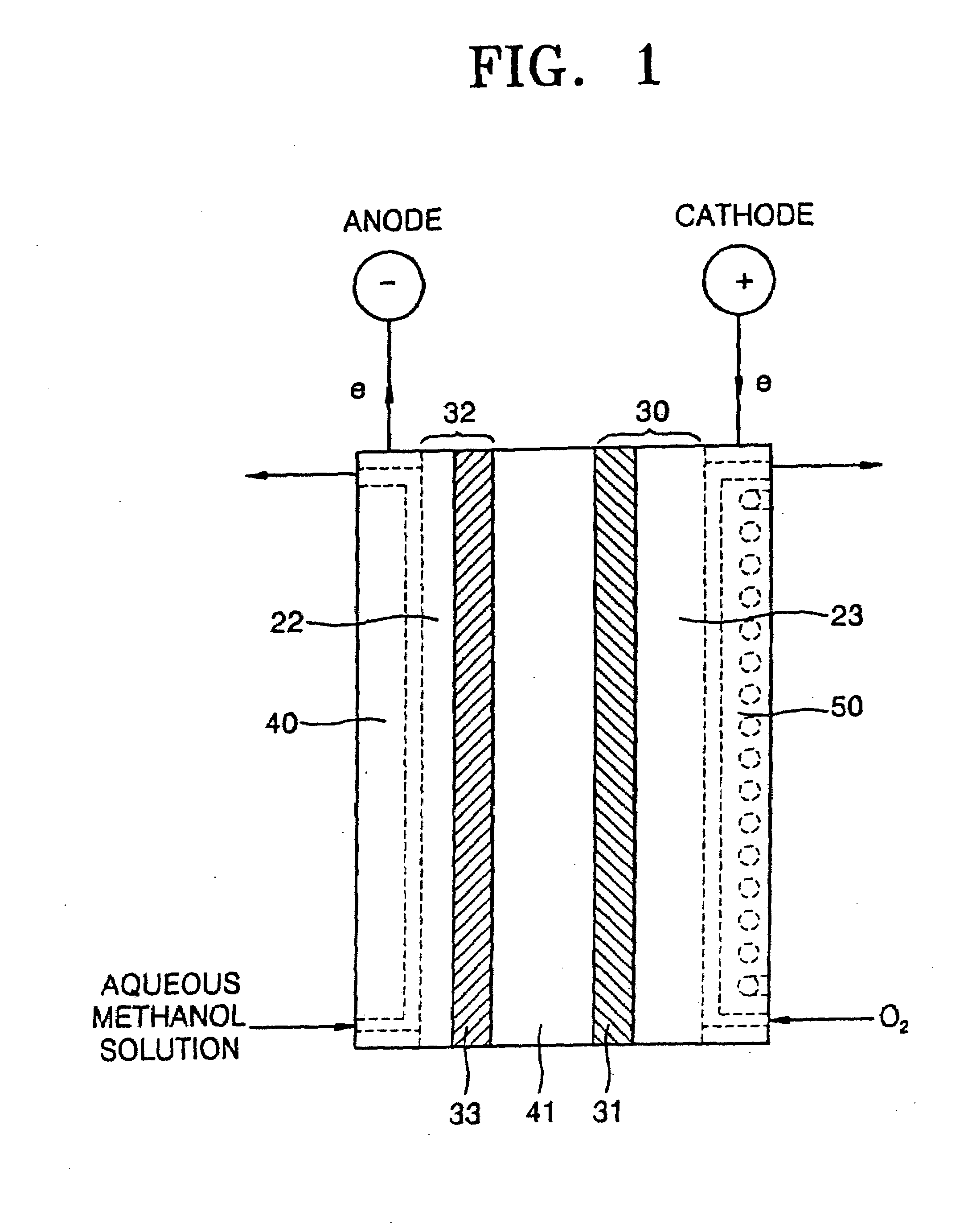Polysiloxane compound containing sulfonic acid groups, method of preparing the same and fuel cell including the same
a technology of polysiloxane and sulfonic acid, which is applied in the direction of non-aqueous electrolyte cells, sustainable manufacturing/processing, non-metal conductors, etc., can solve the problems of dmfc performance decline and electric potential drop, so as to reduce methanol crossover, increase ionic conductivity, and sacrifice ionic conductivity
- Summary
- Abstract
- Description
- Claims
- Application Information
AI Technical Summary
Benefits of technology
Problems solved by technology
Method used
Image
Examples
preparation example 1
Preparation of Hydroxyl-Substituted Polymethylhydrosiloxane
[0077]10 g of polymethylhydrosiloxane (available from Aldrich, trimethylsilyl terminated, about 5,000 of average molecular weight, n is about 80) was injected into a flask, and then was diluted with 100 ml of tetrahydrofuran. 200 mg of 10 wt % Pd / C (palladium / charcoal) was added into the flask. Subsequently, 177.8 mmol (3.20 ml) of distilled water was added into the flask, and hydrogen gas generated during this time was removed. A reaction was performed for 15 hours at room temperature. After the reaction, the resultant was filtered through celite and MgSO4, and then the filtrate was left at a reduced pressure of about 0.1 torr to remove volatile materials. Accordingly, a 10 wt % substituted polymethylhydrosilane solution was obtained. Hydroxyl substitution of the 10 wt % substituted polymethylhydrosiloxane solution was confirmed using IR spectrum.
preparation example 2
Preparation of Sulfonated Phenethyltrimethoxysilane
[0078]11.3 g of phenethyltrimethoxysilane (PETMS) was injected to a 40 ml vial, and then while stirring, 5.8 g of chlorosulfonic acid was slowly, dropwise added to the 40 ml vial. The mixture was stirred for 3 hours at ambient temperature. Accordingly, sulfonated phenethyltrimethoxysilane was obtained by cleaning the mixture with methylene chloride.
preparation example 3
Preparation of Sulfonated poly(ether ether)ketone (SPEEK)(m1=0.8, n1=0.2, k1=1 in Reaction Formula 2)
[0079]
[0080]10.812 g (47.36 mmol) of compound J, 8.267 g (37.88 mmol) of compound K, 4.0 g (9.47 mmol) of compound L, and 8.5 g of anhydrous K2CO3 were injected into a 250 ml 3 hole flask installed with a Dean-Stark trap. Then 120 ml of dimethylsulfoxide and 60 ml of toluene were added into the 250 ml 3 neck flask as solvents.
[0081]The mixture was refluxed for 4 hours at 140° C. with nitrogen, and water generated during this time was removed, and then toluene was removed. The reaction temperature was then increased to 180° C. and polymerization was performed for 16 hours at the same temperature. The resultant was cooled to ambient temperature, and then was precipitated into methanol. To remove inorganic substances, the precipitated copolymer was washed with hot water 3 times. Accordingly, the copolymer formed was dried for 24 hours at 100° C.
PUM
| Property | Measurement | Unit |
|---|---|---|
| Molar ratio | aaaaa | aaaaa |
Abstract
Description
Claims
Application Information
 Login to View More
Login to View More - R&D
- Intellectual Property
- Life Sciences
- Materials
- Tech Scout
- Unparalleled Data Quality
- Higher Quality Content
- 60% Fewer Hallucinations
Browse by: Latest US Patents, China's latest patents, Technical Efficacy Thesaurus, Application Domain, Technology Topic, Popular Technical Reports.
© 2025 PatSnap. All rights reserved.Legal|Privacy policy|Modern Slavery Act Transparency Statement|Sitemap|About US| Contact US: help@patsnap.com



